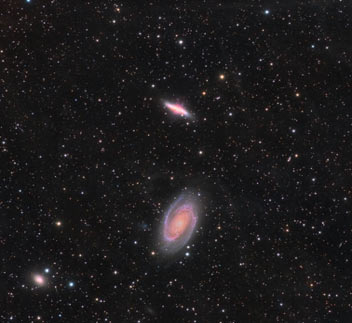This cosmic duet pair of galaxies is one of the deep sky showpieces that captures the imagination of every backyard astronomer. Easily seen through a 4-inch refractor on a dark moonless night and a favorite target for 8-inch SCT owners, M81 and M82 are separated by only 38′. M81 and M82 can even be seen through 50-mm or greater binoculars from a dark country site.

M81
Alternate: NGC 3031, Bode’s Galaxy
Ursa Major
RA 9h 55.6 m
Dec +69º 04′
Magnitude 6.9
M82
Alternate: NGC 3034
Ursa Major
RA 9h 55.8 m
Dec +69º 04′
Magnitude 8.4
Historically, both galaxies were first discovered by Johann Elert Bode on December 31, 1774. Bode described M81, now nicknamed Bode’s Galaxy, as a “nebulous patch,” about 0.75 degrees away from M82, which “appears mostly round and has a dense nucleus in the middle.” According to Bode’s historical notes:
I found through the seven-foot telescope, closely above the head of UMa, east near the star d at its ear, two small nebulous patches separated by about 0.75 degrees, the positions of which relative to the neighbored small stars are shown in the tenth figure. The patch Alpha (M81) appears mostly round and has a dense nucleus in the middle. The other, Beta (M82), on the other hand, is very pale and of elongated shape. I could determine the separation of Alpha to d as 2deg 7′, to Rho as 5deg 2′ and to 2 Sigma as 4deg 32′ with some accuracy; Beta was too faint and disappeared from my eyes as soon as I shifted apart the halves of the objective glass.
Pierre Mechain independently recovered both galaxies in August 1779 and reported their positions to his friend Charles Messier. Messier added both galaxies to his catalog after his position measurements on February 9, 1781, and wrote of the cosmic duet:
Nebula (M82) without star, near the preceding [M81]; both are appearing in the same field of the telescope, this one is less distinct than the preceding; its light faint and [it is] elongated: at its extremity is a telescopic star. Seen at Berlin, by M. Bode, on December 31, 1774, and by M. Mechain in the month August 1779.
The pronounced grand-design spiral galaxies M81 and M82 are part of a nearby group called M81. M81 is characterized in the Hubble classification system as a classic Sa-type galaxy, while M82 is an irregular or IO classification. Astronomers believe tens of million years ago, a close encounter occurred between the galaxies M81 and M82. During this near-miss, the larger and more massive M81 has dramatically deformed M82 by gravitational interaction. The encounter has also left traces in the spiral pattern of the brighter and larger galaxy M81, first making it overall more pronounced, and second in the form of the dark linear feature in the nuclear region. The galaxies are still close together, their centers separated by a linear distance of only about 150,000 light years.
M81 is home to over 250 million stars. M81 is the namesake of the M81 cluster of galaxies, and exhibits a Doppler blue shift, meaning it is approaching the Milky Way instead of receding.
At the center of M81 is a nucleus containing a supermassive black hole that is 15 times the size of the supermassive black hole at the center of the Milky Way.
M81 has two spiral arms containing large quantities of interstellar dust and a number of starburst regions. Spitzer Space Telescope data have revealed young hot blue stars forming in these regions that are heating the interstellar dust, thus increasing the infrared emissions of the galaxy.
M82, the Cigar Galaxy, is one of the most interesting galaxies in the Messier catalog, and has undergone extensive study by astronomers. It is the closest starburst galaxy to Earth and is the prototypical galaxy of this type. M82 also represents one of the smallest galaxies in the Messier catalog. Unlike M81, M82 is redshifted and is receding at a rate of 203 km/sec.
M82 has been long classified as an irregular galaxy. However, near-infrared observations of M82 within the past two decades have revealed two symmetric spiral arms in the galaxy. The near-miss encounter with M81 stimulated star-forming activity within M82 that is ten times that of the Milky Way galaxy.
This pair of galaxies can be seen with 12×60 or 20×80 binoculars, and occasionally with 7×50 binoculars by sharp-eyed observers in very dark sites. My f/7.8 4-inch refractor with a wide-field 24-mm eyepiece with an AFOV of 68º yields a magnification of 36x and a true field of 2.24º. This combination easily captures M81 as a bright oval haze and M82 as a slim cigar shape. The 8-inch SCT with the same eyepiece at 83x and a true FOV of 0.98º begins to show a hazy halo of nebulosity around M81, with M82 displaying a nucleus. Higher magnifications will help bring out the detail, and a larger telescope will bring out additional detail.